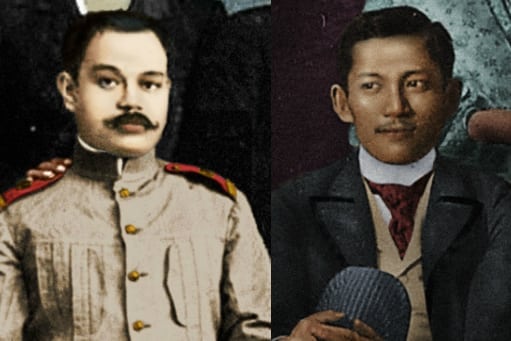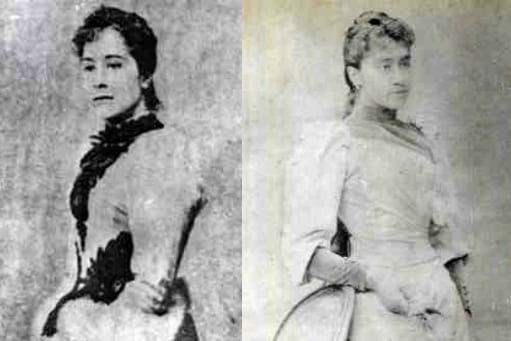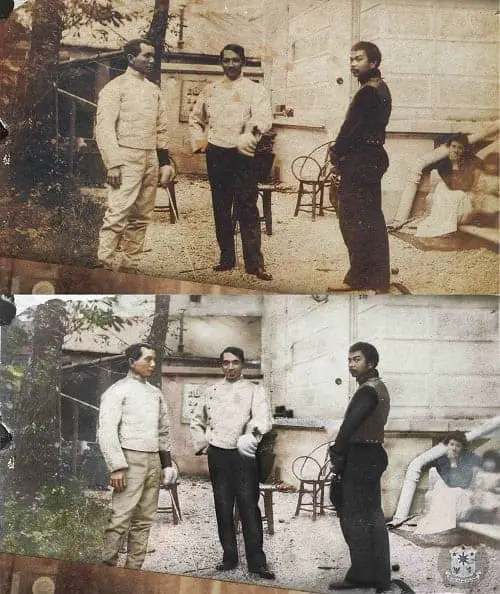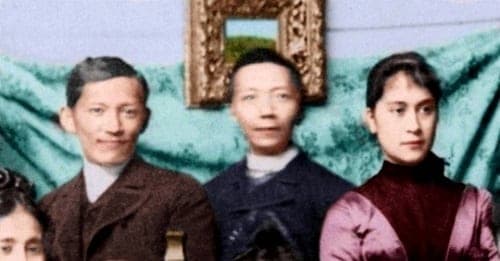The Time Antonio Luna and Jose Rizal Nearly Killed Each Other

If there’s one thing that General Antonio Luna is most famous for other than his assassination, that would be his temper.
This other side of Luna’s personality was seamlessly portrayed in the sleeper hit Heneral Luna wherein the protagonist often clashed with and threw invective to officers who refused to follow his orders.
While Luna’s hotheadedness has changed our perception of the Filipino hero we once thought was deprived of flaws, many believe it also led him to his tragic end.
Also Read: 13 Facts That Prove Antonio Luna Was An All-Around Badass
Before he was hacked to death in Cabanatuan, this Filipino general was already teasing death. Luna, being the sensitive guy that he was, impulsively challenged his perceived enemies to a duel–all in the name of honor.
Surprisingly, among those who found themselves on the receiving end of that legendary temper was Jose Rizal, who became Luna’s friend and compatriot when they’re both studying in Europe. How such friendship almost ended up in a duel remains one of the most intriguing “what-ifs” in Philippine history, an event that would have cost us one or two national heroes were it not for a sudden twist of fate.

Before this heated encounter between the two ilustrados, it was Rizal who ironically urged his fellow expatriates to help Luna in his proposed duel with a Spanish journalist known by the pseudonym Mir Deas.
At that time, Luna had just begun writing his impressions of Madrid in La Solidaridad under the pen name Taga-Ilog. One of Luna’s opinion pieces didn’t sit well with Mir Deas, who wrongly attributed the work to his brother Juan Luna and even described the latter as “ingrate.”
The younger Luna took matters into his own hands and traveled all the way from Madrid to Barcelona. In a letter to Rizal, Luna described how he met Mir Deas face-to-face in a cafe:
“I asked him who he was (I did not know him), called him a vile despicable coward, spat in his face, and threw him my card.”
The Spaniard–who Luna insultingly called Mierdas (Spanish word for shit)–didn’t accept the latter’s invitation to a duel. Instead “he denounced the expatriates to the police for a violation of the printing law.”
Related Article: Inside Antonio Luna’s Secret Love Affair With Ysidra Cojuangco
Luna then returned to Madrid, only to realize that the girl he had been courting was becoming deeply infatuated with Jose Rizal. The subject of both men’s affection was Nelly Boustead, the half-Filipina and half-European who would go down in history as the woman whom Rizal almost married.

Nelly not only captured the hearts of both Luna and Rizal, but also aroused the curiosity of other Filipino propagandists such as Tomas Arejola who said:
“since last year I have heard a number of times here about this young lady…who is also a Filipina. I am told she is to be recommended because of her excellent upbringing, her most attractive moral and physical qualities and, in addition, because she is a Filipina.”
Luna and Rizal often went on dates with Nelly and her younger sister, Adelina. Rizal first met the Bousteads in Paris in the summer of 1889, and they had since become part of a circle of friends also composed of the Luna and the Pardo de Tavera brothers.
Also Read: 22 Things You Didn’t Know About ‘Heneral Luna’
A love triangle soon blossomed, prompting Luna to write a letter to Rizal to address the growing rivalry between them:
“We have no reason to be cold to each other for many times I asked you if you felt love for Nelly and you told me no. Consequently I was already sure of you, certain you are my friend…therefore chico, we ought to continue as friends as I thought we never ceased to be.”
But when he realized that Nelly’s heart didn’t belong to him, anxiety got the better of Antonio Luna. Adding insult to the injury was the fact that his brother, who didn’t trust him, had to send all the money for his education through Rizal.
Luna became a ticking time bomb

Jose Rizal, posing in fencing garb at the Paris home of his friend, artist Juan Luna, with fellow propagandist Valentin Ventura. The woman sitting on the right is believed to be Nelly Boustead. Photo credit: Presidential Communications Development and Strategic Planning Office.
The big explosion came in the summer of 1890, when both men attended a reunion of Filipino exiles in Madrid.
Antonio Luna got drunk, and as with any person who suddenly becomes braver under the influence of alcohol, made a sarcastic remark about Nelly and Rizal. An argument ensued between the two men, with one of them challenging the other to a duel.
Also Read: 10 Near-Deaths That Almost Changed Philippine History
Although it’s not sure who challenged who (historians have different accounts), the said duel didn’t push through thanks to the cooler heads who intervened.
Luna was brought to his home and apologized to Rizal as soon as he sobered up. On behalf of his brother, Juan Luna also wrote a letter of apology to Rizal from France in August 1890:
“I suppose that this incident will not be the cause of any resentment between the Filipinos and Antonio, for, having taken back what he had said and gave them permission to tie him if he got drunk again, he showed that he was repentant of the evil he had caused the gathering and his friends…..It is true that Antonio has a strong character and he is very sensitive. This is very good if the cause is just.”
Months after the confrontation, Rizal went to France for a vacation, staying at the Boustead residence in the seaside resort town of Biarritz. It was here where the affection between the love-struck Jose and Nelly grew stronger.
As for the hopeless Luna, he finally conceded and wrote Rizal another letter, this time without any sign of bitterness:
“With respect to Nelly, frankly, I think there is nothing between us more than one of those friendships enlivened by being fellow countrymen. It seems to me that there is nothing more. My word of honor… I believe that she will bring happiness not only to you but to any other man who is worthy of her. I congratulate you as one congratulates a friend.”
Unfortunately, Jose Rizal and Nelly Boustead didn’t end up happily ever after. The romance ended as soon as Nelly insisted on Rizal embracing Protestantism.
Turns out, her condition was too much for Rizal who was no longer a fan of organized religion.

And that’s how their relationship came to a close, which would have ended in marriage if only the prerequisite was out of the picture.
Related Article: The 6 Most Tragic Love Stories in Philippine History
We all know what happened to Rizal and Luna after this love triangle collapsed. But what if the duel did happen? It’s useless for us now to even consider the possibilities, but this story only proves how emotions as simple as love and jealousy could alter the course of Philippine history forever.
References
Guerrero, L. (1963). The First Filipino, A Biography of Jose Rizal. National Heroes Commission.
Ocampo, A. (2001). The hotheaded Antonio Luna. Philippine Daily Inquirer, p. A9. Retrieved from https://goo.gl/7RKqS1
Ocampo, A. (2015). Antonio Luna and his temper. Inquirer.net. Retrieved 7 October 2015, from http://goo.gl/GXCqMT
Reyes, R. (2008). Love, Passion and Patriotism: Sexuality and the Philippine Propaganda Movement, 1882-1892 (pp. 108-109;111). NUS Press.
Severino, H. (2011). Looking for Rizal in Europe, finding a ‘little bad boy’. GMA News Online. Retrieved 7 October 2015, from http://goo.gl/KPE3rB
Written by FilipiKnow
FilipiKnow
FilipiKnow strives to ensure each article published on this website is as accurate and reliable as possible. We invite you, our reader, to take part in our mission to provide free, high-quality information for every Juan. If you think this article needs improvement, or if you have suggestions on how we can better achieve our goals, let us know by sending a message to admin at filipiknow dot net
Copyright Notice
All materials contained on this site are protected by the Republic of the Philippines copyright law and may not be reproduced, distributed, transmitted, displayed, published, or broadcast without the prior written permission of filipiknow.net or in the case of third party materials, the owner of that content. You may not alter or remove any trademark, copyright, or other notice from copies of the content. Be warned that we have already reported and helped terminate several websites and YouTube channels for blatantly stealing our content. If you wish to use filipiknow.net content for commercial purposes, such as for content syndication, etc., please contact us at legal(at)filipiknow(dot)net
